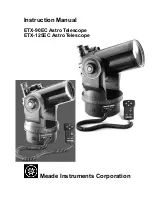
object relatively centered in the eyepiece. Using higher magnification means that you
have to make more frequent tracking adjustments than when using lower magnification.
A popular method for locating night sky objects is called “star-hopping.” Start by finding
a known star or moon or planet, and scan from there to other stars closer to the
destination object. This method is far from new but it might take a little time to master
requiring at least a rudimentary familiarity with the location of a variety of celestial
objects. However, learning to star-hop makes object location much quicker and gets
you to where you want to be without much fuss. Experience will make this easier and
dramatically increase your personal knowledge of the night sky! You don’t need to
memorize every single object in the night sky, but it can be very rewarding just knowing
a handful of the most prominent sights such as the Orion constellation, the Big Dipper,
the North Star, etc.
A star chart will help you determine which constellation your target object is near. Find
the brightest star in that constellation and place it in the center of your eyepiece. Again
refer back to your star chart to figure out the next brightest star as you gradually move
towards your intended target. If you are unsuccessful at first, please be patient and
repeat the steps until your final destination is in view. Again, your speed will increase
with experience.
Procedure for collimation
CAUTION: Do NOT allow the laser to shine in your eye (either directly or indirectly off
the telescope’s mirrors) as that may damage your eye permanently
.
1.
Remove any eyepiece from the focuser.
2.
Look into the focuser and confirm that you see the secondary mirror centered in
the hole. Reflected in the secondary mirror, you should be able to see the primary
mirror and the three small clips around the edge of the primary mirror. If not, you
will need to rotate the secondary mirror assembly with your hand (be careful not
to TOUCH the reflective surface of the secondary mirror itself) until the reflection
of the primary mirror is centered in the secondary mirror. In addition, although
Summary of Contents for Dobsonian Telescope
Page 1: ......
Page 3: ...DOBSONIAN TELESCOPE Assembly Instructions and User s Guide...
Page 22: ...2015 Rev 3 15...






























